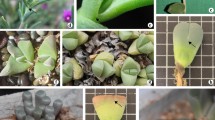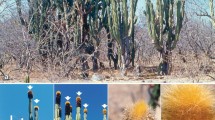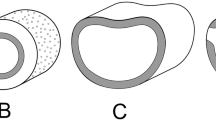Abstract
It is well known that an endodermis with casparian strip always occurs in roots, but few people are aware that it also occurs in stems and leaves of some vascular plants. The rather sparse literature on endodermis in aerial organs was last included in a review in 1943. The present compilation, which does not consider hydathodes, nectaries, or other secretory structures, emphasizes distribution of cauline and foliar endodermis with casparian strip. It occurs unevenly among major taxa: quite common in rhizomes and leaves among pteridophyte groups, with exceptions; absent in gymnosperm stems but found in leaves at least among some conifers; in stems of at least 30 mostly herbaceous angiosperm families, but far less common in leaves, where it is mostly reported from petioles. Etiolation can induce casparian strips in stems and petioles of some herbaceous plants, but results from leaf blades are questionable. There are recent reports of an endodermis with casparian strip in leaves of both woody and herbaceous taxa. The physiological function, if any, of a casparian strip in aerial organs remains unknown.
Similar content being viewed by others
Literature Cited
Bond, G. 1931. The stem endodermis in the genusPiper. Trans. Roy. Soc. Edinburgh56: 695–724.
Buchholz, J. T. 1951. A flat-leaved pine from Annam, Indo-China. Amer. J. Bot.38: 245–252.
Carde, J-P. 1978. Ultrastructural studies ofPinus pinaster needles: the endodermis. Amer. J. Bot.65: 1041–1054.
Chamberlain, C. J. 1935. Gymnosperms. Structure and evolution. University of Chicago Press, Chicago.
Codaccioni, M. 1970. Presence de cellules de type endodermique dans la tige de quelques Dicotyledones. Compt. Rend. Acad. Sci. Paris, Sér. D, Sci. Nat.271: 1515–1517.
Cordemoy, J. de. 1923. Contribution a l’étude de la morphologie, de l’anatomie comparée, de la phytogenie et de la biogeographie des Casuarinacées. Rev. Gen. Bot.35: 71–91, 127–140, 186–195, 227–243, 292–303, 335–347, 399–415.
Cutter, E. G. 1971. Plant anatomy. Part 2. Organs. Edward Arnold, London.
Damus, M., R. L. Peterson, D. E. Enstone &C. A. Peterson. 1997. Modifications of cortical cell walls in roots of seedless vascular plants. Bot. Acta110: 190–195.
Dickison, W. G. &A. L. Weitzman. 1996. Comparative anatomy of the young stem, node, and leaf of the Bonnetiacae, including observations on a foliar endodermis. Amer. J. Bot.83: 405–418.
Esau, K. 1965. Plant anatomy. Ed. 2. John Wiley & Sons, New York.
Fahn, A. 1990. Plant anatomy. Ed. 4. Pergamon Press, Oxford.
Gambles, R. L. &N. G. Dengler. 1973. The leaf anatomy of hemlock,Tsuga canadensis. Canad. J. Bot.52: 1049–1056.
Gifford, E. M. &A. S. Foster. 1989. Morphology and evolution of vascular plants. Ed. 3. W. H. Freeman, New York.
Guttenberg, H. von. 1943. Die physiologischen Scheiden. Handb. Pflanzenanat., Abteil 1, Teil 2, Band V. Gebruder Borntraeger, Berlin.
Holm, T. 1907a. Rubiaceae: anatomical studies of North American representatives ofCephalanthus, Oldenlandia, Houstonia, Mitchella, Diodia, andGalium. Bot. Gaz.43:153–186.
—. 1907b.Ruellia andDianthera: an anatomical study. Bot. Gaz.43: 308–329.
Hufford, L. 1992. Leaf structure ofBesseya andSynthris (Scrophulariaceae). Canad. J. Bot.70: 921–932.
Keng, H. &E. L. Little Jr. 1961. Needle characteristics of hybrid pines. Silv. Genet.10: 131–146.
Lederer, B. 1955. Vergleichende Untersuchungen über das Transfusiongewebe einiger rezenten Gymnospermen. Bot. Stud.4: 1–42.
Lyshede, O. B. 1989. Electron microscopy of the filiform seedling axis ofCuscuta pedicellata. Bot. Gaz.150: 230–238.
Mauseth, J. D. 1988. Plant anatomy. Benjamin/Cummings, Menlo Park, California.
Metcalfe, C. R. &L. Chalk. 1979. Anatomy of the dicotyledons. Vol. 1. Ed. 2. Clarendon Press, Oxford.
Mylius, G. 1913. Das Polyderm. Eine vergleichende Untersuchung über die physiologischen Scheiden Polyderm, Periderm und Endodermis. Bibl. Bot.79: 1–119.
Napp-Zinn, K. 1966. Anatomie des Blattes. I. Gymnospermen. Handb. Pflanzenanat. Spezieller Teil, Band VIII, Teil 1. Gebruder Borntraeger, Berlin.
—. 1973-1974. Anatomie des Blattes. II. Blattanatomie der Angiospermen. 2 vols. Handb. Pfianzenanat. Spezieller Teil, Band VIII, Teil 2A, Lieferung 1 and 2. Gebruder Borntraeger, Berlin.
Ogura, Y. 1938. Anatomie der Vegetationsorgane der Pteridophyten. Handb. Pflanzenanat, Abt. II, Bd. VII, Teil 2. Gebruder Borntraeger, Berlin.
—. 1972. Comparative anatomy of vegetative organs of the Pteridophytes. Ed. 2. Encyclopedia of plant anatomy. Bd. VII, Teil 3. Gebruder Borntraeger, Berlin.
Owens, J. N. 1968. Initiation and development of leaves in Douglas fir. Canad. J. Bot.46: 271–278.
Plaut, M. 1910. Untersuchungen über die physiologischen Scheiden der Gymnospermen, Equisetaceen und Bryophyten. Jahrb. Wiss. Bot.47: 121–185.
Scholz, F. &J. Bauch. 1973. Anatomische und physiologische Untersuchungen zur Wasserbewegung in Kiefernadeln. Planta109:105–119.
Soar, I. 1922. The structure and function of the endodermis in the leaves of the Abietineae. New Phytol.21: 269–292.
Trapp, G. A. 1933. A study in the foliar endodermis of the Plantaginaceae. Trans. Roy. Soc. Edinburgh57, II: 523–546.
Van Fleet, D. S. 1942. The development and distribution of the endodermis and an associated oxidase system in monocotyledonous plants. Amer. J. Bot.29:1–19.
—. 1950. The cell forms, and their common substance reactions, in the parenchyma-vascular boundary. Bull. Torrey Bot. Club77: 340–353.
—. 1961. Histochemistry and function of the endodermis. Bot. Rev. (Lancaster)27:165–220.
Warmbrodt, R. D. 1984. Structure of the leaf ofPyrossia longifolia—a fern exhibiting crassulacean acid metabolism. Amer. J. Bot.71:330–347.
— &R. F. Evert. 1978. Comparative leaf structure of six species of heterosporous ferns. Bot. Gaz.139: 393–429.
——. 1979a. Comparative leaf structure of six species of eusporangiate and protoleptosporangiate ferns. Bot. Gaz.140:153–167.
—. 1979b. Comparative leaf structure of several species of homosporous leptosporangiate ferns. Amer. J. Bot.66: 412–440.
Wylie, R. B. 1948. The dominant role of the epidermis in leaves ofAdiantum. Amer. J. Bot.35: 465–473.
Author information
Authors and Affiliations
Rights and permissions
About this article
Cite this article
Lersten, N.R. Occurrence of endodermis with a casparian strip in stem and leaf. Bot. Rev 63, 265–272 (1997). https://doi.org/10.1007/BF02857952
Issue Date:
DOI: https://doi.org/10.1007/BF02857952




